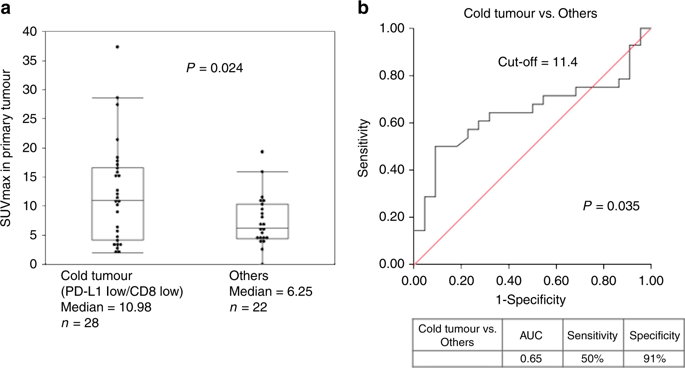当前位置:
X-MOL 学术
›
Br. J. Cancer
›
论文详情
Our official English website, www.x-mol.net, welcomes your
feedback! (Note: you will need to create a separate account there.)
Diagnostic value of 18F-FDG-PET to predict the tumour immune status defined by tumoural PD-L1 and CD8+tumour-infiltrating lymphocytes in oral squamous cell carcinoma.
British Journal of Cancer ( IF 6.4 ) Pub Date : 2020-04-02 , DOI: 10.1038/s41416-020-0820-z Maria Togo 1 , Takehiko Yokobori 2 , Kimihiro Shimizu 3 , Tadashi Handa 1 , Kyoichi Kaira 4 , Takaaki Sano 1 , Mariko Tsukagoshi 2 , Tetsuya Higuchi 5 , Satoshi Yokoo 6 , Ken Shirabe 3 , Tetsunari Oyama 1
British Journal of Cancer ( IF 6.4 ) Pub Date : 2020-04-02 , DOI: 10.1038/s41416-020-0820-z Maria Togo 1 , Takehiko Yokobori 2 , Kimihiro Shimizu 3 , Tadashi Handa 1 , Kyoichi Kaira 4 , Takaaki Sano 1 , Mariko Tsukagoshi 2 , Tetsuya Higuchi 5 , Satoshi Yokoo 6 , Ken Shirabe 3 , Tetsunari Oyama 1
Affiliation

|
BACKGROUND
Lately, immune checkpoint proteins, such as programmed death 1 (PD-1) and its ligand-1 (PD-L1), have garnered attention as a new target in oral squamous cell carcinoma (OSCC). Reportedly, fluoro-D-glucose (FDG)-uptake alteration by anti-PD-1 antibody treatment depicts the response in patients with lung cancer. This study aims to elucidate the correlations between tumour immune status, clinicopathological factors, 18F-FDG-uptake and cold tumour phenotypes as low PD-L1 expression/low CD8+tumour-infiltrating lymphocytes (TILs) in OSCC.
METHODS
We performed immunohistochemical analysis of PD-L1, hypoxia-inducible factor 1 A (HIF-1A), glucose transporter type 1 (GLUT1), CD8, E-cadherin and Ki-67 on 59 operable OSCC samples. We assessed the correlations between these factors and preoperative 18F-FDG-uptake, clinicopathological characteristics and prognosis.
RESULTS
Low expression of PD-L1 in OSCC correlated with cancer aggressiveness, poor prognosis, high 18F-FDG-uptake with HIF-1A/GLUT1 and low E-cadherin expression and low CD8. Cold tumour phenotypes as low PD-L1 tumour cells and low stromal CD8 correlated with the poor prognosis, high 18F-FDG-uptake and E-cadherin suppression. Furthermore, the high level of preoperative 18F-FDG-uptake in OSCC was an independent predictor of the cold tumour immune status.
CONCLUSIONS
18F-FDG-uptake is an independent predictor of cold tumour in OSCC. 18F-FDG-PET imaging could be a promising diagnostic tool to estimate tumour immune status.
中文翻译:

18F-FDG-PET 预测口腔鳞状细胞癌中由肿瘤 PD-L1 和 CD8+ 肿瘤浸润淋巴细胞定义的肿瘤免疫状态的诊断价值。
背景 最近,免疫检查点蛋白,例如程序性死亡蛋白 1 (PD-1) 及其配体-1 (PD-L1),作为口腔鳞状细胞癌 (OSCC) 的新靶点而受到关注。据报道,抗 PD-1 抗体治疗引起的氟-D-葡萄糖 (FDG) 摄取改变描述了肺癌患者的反应。本研究旨在阐明 OSCC 中肿瘤免疫状态、临床病理学因素、18F-FDG 摄取和冷肿瘤表型之间的相关性,如低 PD-L1 表达/低 CD8+ 肿瘤浸润淋巴细胞 (TIL)。方法 我们对 59 个可操作的 OSCC 样本进行了 PD-L1、缺氧诱导因子 1A (HIF-1A)、1 型葡萄糖转运蛋白 (GLUT1)、CD8、E-钙粘蛋白和 Ki-67 的免疫组织化学分析。我们评估了这些因素与术前 18F-FDG 摄取之间的相关性,临床病理特征和预后。结果 OSCC 中 PD-L1 的低表达与癌症侵袭性、不良预后、高 18F-FDG 摄取和 HIF-1A/GLUT1 以及低 E-钙粘蛋白表达和低 CD8 相关。低 PD-L1 肿瘤细胞和低基质 CD8 的冷肿瘤表型与不良预后、高 18F-FDG 摄取和 E-钙粘蛋白抑制相关。此外,OSCC 术前高水平的 18F-FDG 摄取是冷肿瘤免疫状态的独立预测因子。结论 18F-FDG 摄取是 OSCC 冷肿瘤的独立预测因子。18F-FDG-PET 成像可能是一种很有前途的诊断工具,用于评估肿瘤免疫状态。HIF-1A/GLUT1 的 18F-FDG 摄取率高,E-钙粘蛋白表达低,CD8 低。低 PD-L1 肿瘤细胞和低基质 CD8 的冷肿瘤表型与不良预后、高 18F-FDG 摄取和 E-钙粘蛋白抑制相关。此外,OSCC 术前高水平的 18F-FDG 摄取是冷肿瘤免疫状态的独立预测因子。结论 18F-FDG 摄取是 OSCC 冷肿瘤的独立预测因子。18F-FDG-PET 成像可能是一种很有前途的诊断工具,用于评估肿瘤免疫状态。HIF-1A/GLUT1 的 18F-FDG 摄取率高,E-钙粘蛋白表达低,CD8 低。低 PD-L1 肿瘤细胞和低基质 CD8 的冷肿瘤表型与不良预后、高 18F-FDG 摄取和 E-钙粘蛋白抑制相关。此外,OSCC 术前高水平的 18F-FDG 摄取是冷肿瘤免疫状态的独立预测因子。结论 18F-FDG 摄取是 OSCC 冷肿瘤的独立预测因子。18F-FDG-PET 成像可能是一种很有前途的诊断工具,用于评估肿瘤免疫状态。结论 18F-FDG 摄取是 OSCC 冷肿瘤的独立预测因子。18F-FDG-PET 成像可能是一种很有前途的诊断工具,用于评估肿瘤免疫状态。结论 18F-FDG 摄取是 OSCC 冷肿瘤的独立预测因子。18F-FDG-PET 成像可能是一种很有前途的诊断工具,用于评估肿瘤免疫状态。
更新日期:2020-04-24
中文翻译:

18F-FDG-PET 预测口腔鳞状细胞癌中由肿瘤 PD-L1 和 CD8+ 肿瘤浸润淋巴细胞定义的肿瘤免疫状态的诊断价值。
背景 最近,免疫检查点蛋白,例如程序性死亡蛋白 1 (PD-1) 及其配体-1 (PD-L1),作为口腔鳞状细胞癌 (OSCC) 的新靶点而受到关注。据报道,抗 PD-1 抗体治疗引起的氟-D-葡萄糖 (FDG) 摄取改变描述了肺癌患者的反应。本研究旨在阐明 OSCC 中肿瘤免疫状态、临床病理学因素、18F-FDG 摄取和冷肿瘤表型之间的相关性,如低 PD-L1 表达/低 CD8+ 肿瘤浸润淋巴细胞 (TIL)。方法 我们对 59 个可操作的 OSCC 样本进行了 PD-L1、缺氧诱导因子 1A (HIF-1A)、1 型葡萄糖转运蛋白 (GLUT1)、CD8、E-钙粘蛋白和 Ki-67 的免疫组织化学分析。我们评估了这些因素与术前 18F-FDG 摄取之间的相关性,临床病理特征和预后。结果 OSCC 中 PD-L1 的低表达与癌症侵袭性、不良预后、高 18F-FDG 摄取和 HIF-1A/GLUT1 以及低 E-钙粘蛋白表达和低 CD8 相关。低 PD-L1 肿瘤细胞和低基质 CD8 的冷肿瘤表型与不良预后、高 18F-FDG 摄取和 E-钙粘蛋白抑制相关。此外,OSCC 术前高水平的 18F-FDG 摄取是冷肿瘤免疫状态的独立预测因子。结论 18F-FDG 摄取是 OSCC 冷肿瘤的独立预测因子。18F-FDG-PET 成像可能是一种很有前途的诊断工具,用于评估肿瘤免疫状态。HIF-1A/GLUT1 的 18F-FDG 摄取率高,E-钙粘蛋白表达低,CD8 低。低 PD-L1 肿瘤细胞和低基质 CD8 的冷肿瘤表型与不良预后、高 18F-FDG 摄取和 E-钙粘蛋白抑制相关。此外,OSCC 术前高水平的 18F-FDG 摄取是冷肿瘤免疫状态的独立预测因子。结论 18F-FDG 摄取是 OSCC 冷肿瘤的独立预测因子。18F-FDG-PET 成像可能是一种很有前途的诊断工具,用于评估肿瘤免疫状态。HIF-1A/GLUT1 的 18F-FDG 摄取率高,E-钙粘蛋白表达低,CD8 低。低 PD-L1 肿瘤细胞和低基质 CD8 的冷肿瘤表型与不良预后、高 18F-FDG 摄取和 E-钙粘蛋白抑制相关。此外,OSCC 术前高水平的 18F-FDG 摄取是冷肿瘤免疫状态的独立预测因子。结论 18F-FDG 摄取是 OSCC 冷肿瘤的独立预测因子。18F-FDG-PET 成像可能是一种很有前途的诊断工具,用于评估肿瘤免疫状态。结论 18F-FDG 摄取是 OSCC 冷肿瘤的独立预测因子。18F-FDG-PET 成像可能是一种很有前途的诊断工具,用于评估肿瘤免疫状态。结论 18F-FDG 摄取是 OSCC 冷肿瘤的独立预测因子。18F-FDG-PET 成像可能是一种很有前途的诊断工具,用于评估肿瘤免疫状态。











































 京公网安备 11010802027423号
京公网安备 11010802027423号